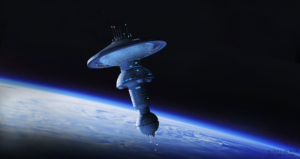This is the second in a series of articles regarding common misconceptions about space. The first of its number dealt with the vast distances involved when considering space, and this one will deal with the idea that “Space is cold”, and about space nebula.
Even Star Trek’s writers almost always got nebulas completely and utterly wrong. Voyager… I’m looking at you.
Anyway, let’s see what we can discover. 😀
#3 – Space is cold.
Ensign Generic freezes in panic. A hull breach…! Every space-sailor’s worst nightmare. As he’s thrown out into space, his body snap-freezes into a giant hunk of ice… and the moment his hand touches the metal of the hull, his whole body explodes into ice chunks.
Or maybe not.
There are many reasons why the above wouldn’t occur, but the biggest one is that space is a brilliant insulator. A Thermos works by having a layer of vacuum around it to prevent heat entering or escaping. Although even the best Thermos is a fairly good vacuum, space is even more empty than that. So it’s like being inside a giant Thermos…
In fact, one of the biggest problems spacecraft have is that they’re a closed system. There’s nowhere for excess heat to go. Although many of you may remember the scene in Apollo 13 when the ship began to freeze, and that really did happen, this process took days, and occurred only after they’d shut down almost every conceivable system, and in a vessel specifically designed to radiate away as much heat as possible (it’s easy to generate heat, hard to get rid of it).
So is space hot? No, not really.
While space is empty (see point #2), and also very insulating, there’s nothing to trap and hold onto heat… but heat does pass through it, especially near the sun. Just ask Mercury… or Earth. I mean, the sun that shines down on you from space had to pass through our atmosphere first, so… it’s pretty hot up there. You’re far, far more likely to roast to death than freeze, unless you’re very far away. If you left something out in deep space (or out past Uranus way) for a very long time, it would eventually freeze fairly solid. But the space around Earth, and the space for most of the solar system, isn’t cold… and even the places that are, space is an insulator. The freezing would take time.
(Warning: mild physics ahead) One effect to note is the fact that water freezes and boils at specific temperatures at sea level (specifically 0 degrees Celcius to freeze, 100 degrees Celcius to boil). At higher altitudes the air pressure is lower, so it boils at much lower temperatures. In space, there’s essentially very very little pressure, so water (and blood!) boils extremely easily. The exposed water around your eyes and mouth, exposed to vacuum, would begin to boil due to this pressure differential; but your blood is perfectly safe (your body keeps it at a suitable pressure). Just note that this effect is caused by the pressure only, not heat or cold.
#4 – Space nebula are giant clouds.
Star Trek: Voyager is guilty of this one.
In “Year of Hell“, the crippled starship Voyager hides inside a nebula so dense that it produces a visible fog inside the ship’s corridors. Captain Janeway even orders the hull breaches sealed to avoid having an “indoor nebula.” This implies that the pressure of the nebula is greater than the atmospheric pressure inside.
You remember how we learned that space is empty?
Unless there’s some kind of gravity holding gasses together, such as a planet, they eventually disperse… becoming vast pockets of space that contains slightly more hydrogen/helium/etc atoms than nothing. If you were flying through one, it would be… just like flying through any other part of space. The most perfect vacuum Humans can make on Earth contains more contaminants in it than the most dense nebula we’ve discovered so far.
Nebulas are basically empty, only they’re just slightly less empty than the great void between galaxies. A hull breach inside a nebula is indistinguishable from a hull breach in any other part of space.
To Be Continued…
So we know that space is both big and empty, and not cold (or is it!), and nebula are not what Voyager made them out to be. What other misconceptions can we explore? Well, in future articles we’ll learn about how explosions work in space, how stealth in space works, how guns work just fine in space thank you very much, and a whole lot more. Stay tuned…
The author would like to thank this TV Tropes article for its incredible insight and life-destroying power in equal measure.


















